The product manager job title is fast becoming one of the hottest in business. From a hiring perspective, product managers are crucial to company growth and success.
For those in the job market, product management offers a varied, fast-paced, and rewarding career path.
But what does a product manager actually do? What tasks and responsibilities do they typically take on, and what’s their exact function within an organization?
Consider this your complete product manager career guide. We’ll explain, in no uncertain terms, what a product manager does—as well as the skills that are necessary to succeed in the role.
And, if you’re reading about product management with your own career in mind, we’ll share some tips for how you can get started as a product manager.
Here’s what we’ll cover. If you’d like to skip ahead to a certain section, simply use the clickable menu:
- What is product management?
- What does a product manager do? An overview
- A closer look at product manager job descriptions
- What does a product manager do? Day-to-day tasks & responsibilities
- How much do product managers earn?
- What skills do you need to be a product manager?
- How to become a product manager
So: What does a product manager do? Let’s find out.
1. What is product management?
In a business or organization, the product management department is responsible for overseeing the entire life cycle of a product or service. Those who work in product management—be it a solo product manager or an entire team—guide and manage the planning, development, and launch of the product. They also continue to manage the product once it’s on the market.
Product management is a strategic function. It’s all about factoring in the end user needs and the business goals to develop a strategy and vision for the product which, ideally, satisfies both.
It’s a multidisciplinary field, spanning user experience (UX), business, and technology. Product managers are required to wear many hats, making it a varied, fast-paced, and exciting field to be part of.
You’ll find a complete introductory guide to product management (and the product life cycle) in this guide we’ve created.
Another way is to get a good sense of it is to let an expert explain. Let CareerFoundry’s own senior product owner Zöe talk you throw what a product manager does:
2. What does a product manager do? The role in a nutshell
The role of the product manager is to develop a strategy and a vision for the product or service, and to coordinate and oversee the implementation of that vision. They guide the development of the product to ensure that it not only meets the end user’s needs, but also drives growth in line with business goals.
The product manager is the go-to person for anything relating to the product. They collaborate closely with many different stakeholders across the business—including the leadership team, designers, developers, sales and marketing, and customer care teams. Ultimately, anyone who is involved with the product or service in some way will be in contact with the product manager.
In a nutshell, product managers:
- Understand both the end user’s needs and the overarching business goals
- Develop a strategy which guides the development and maintenance of successful products
- Coordinate all the moving parts of the product life cycle, from ideation and development, right through to launch and beyond
- Keep everybody in the organization aligned and working towards a common goal for the product
So far, we’ve offered a bird’s-eye view of the product manager role. Now, let’s zoom in even closer and take a look at some product manager job descriptions.
3. A closer look at product manager job descriptions
One of the best ways to gain an understanding of what a product manager actually does is to look at job ads. You can see what hiring managers typically expect from a product manager, and get an idea of how the role can vary from company to company.
So let’s do just that. Here are some job descriptions based on real job ads that are live at the time of writing. If you’d like to check out more of these, we’ve got a full guide to product manager job descriptions.
Spotify
Our first product manager job description comes from a job ad posted by Spotify. Specifically, this role is for a product manager to manage Spotify for Artists, a platform which helps artists to curate their presence on Spotify, to understand their fanbase, and to grow their profile.

For the role, Spotify is looking for a product manager to define the strategy and execution of products to drive artist presence and build on existing features, to identify new opportunities to empower artists (i.e. the end user), and to collaborate cross-functionally to balance risk and value.
The product manager will be expected to “handle a large scope of diverse problem spaces, inclusive of technical optimizations as well as strategy,” and to “learn the technology that powers Spotify for Artists tools and collaborate with the tech team to facilitate trade-offs between tech debt and new feature work.”
Last but not least, the product manager will “build a roadmap to drive real value for Artists, Fans, and Spotify, with milestones for success” and “collaborate with cross-functional teams to evangelize product strategy and influence successful go-to-market.”
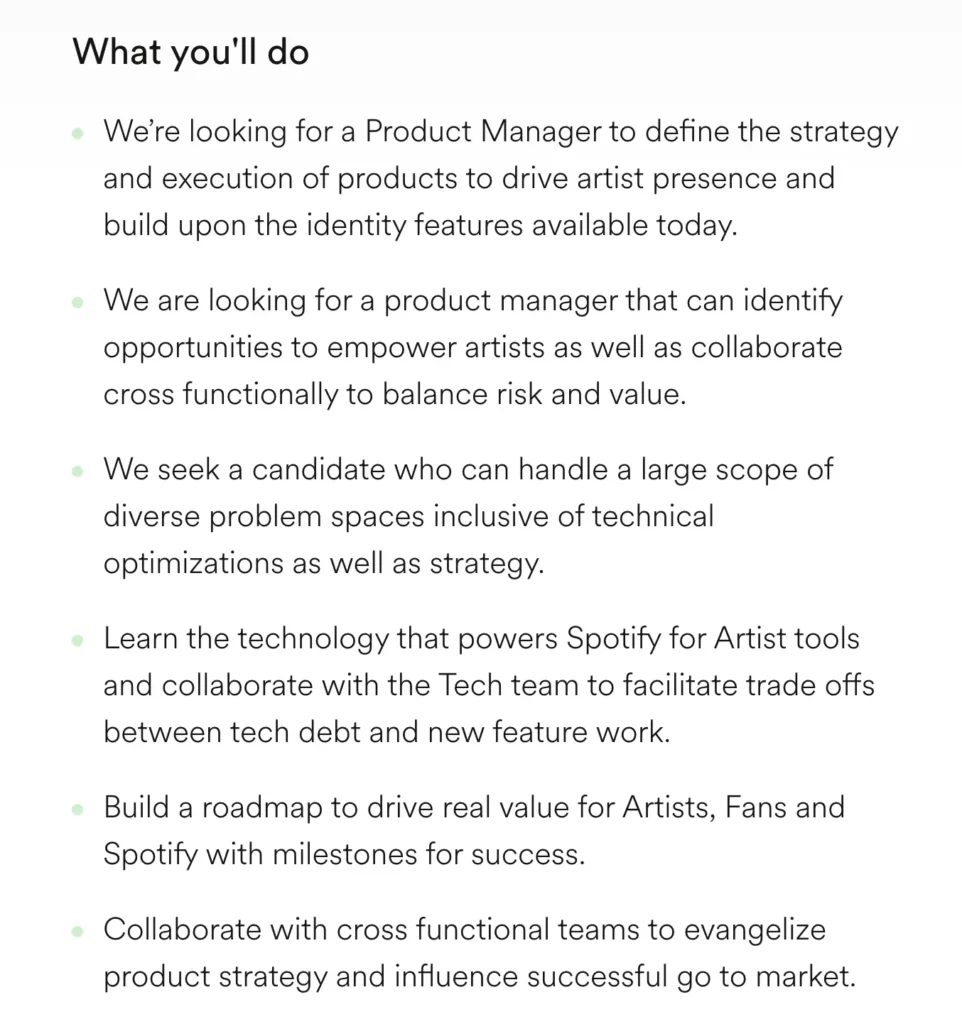
As you can see, the role of the product manager is strategic and collaborative, requiring excellent communication, prioritization, and problem-solving skills.
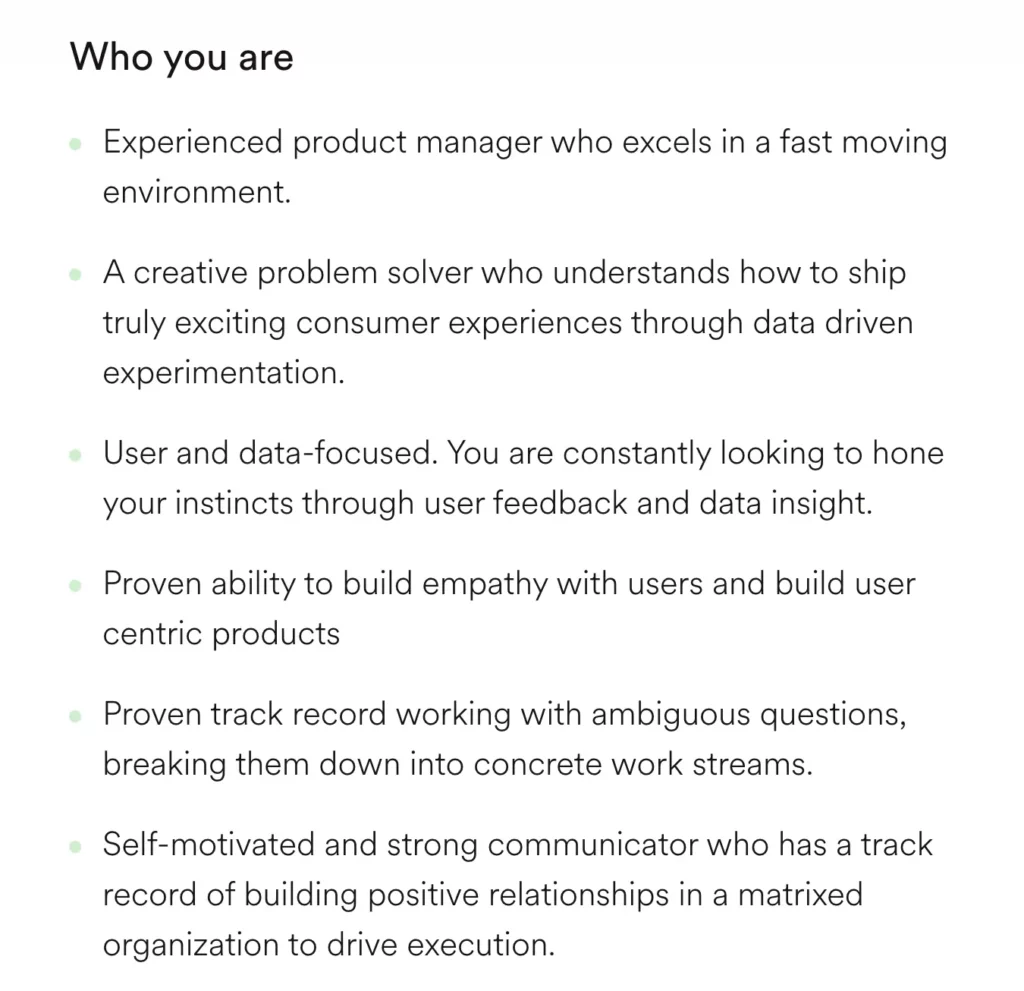
Spotify describes the ideal candidate as someone who “excels in a fast-moving environment” and is a “creative problem-solver who understands how to ship truly exciting consumer experiences through data-driven experimentation.”
The product manager should also be user and data-focused, have an ability to build empathy with users, be a strong communicator, and have a proven track record of “working with ambiguous questions and breaking them down into concrete work streams.”
Bear in mind that this ad is for an experienced product manager, so the skills and expertise required are relatively advanced.
Netflix
Our next example is a product manager job ad posted by streaming giant Netflix. In this particular role, the product manager will “design, strategize, execute, and prioritize projects.” They should be “comfortable in a fast-paced environment” and be able to “build consensus and alignment without being afraid to push ahead when there remain some critics.”
This speaks to the careful balancing act that product managers must often perform: managing different needs, expectations, and opinions in order to prioritize effectively with the overarching goals in mind.
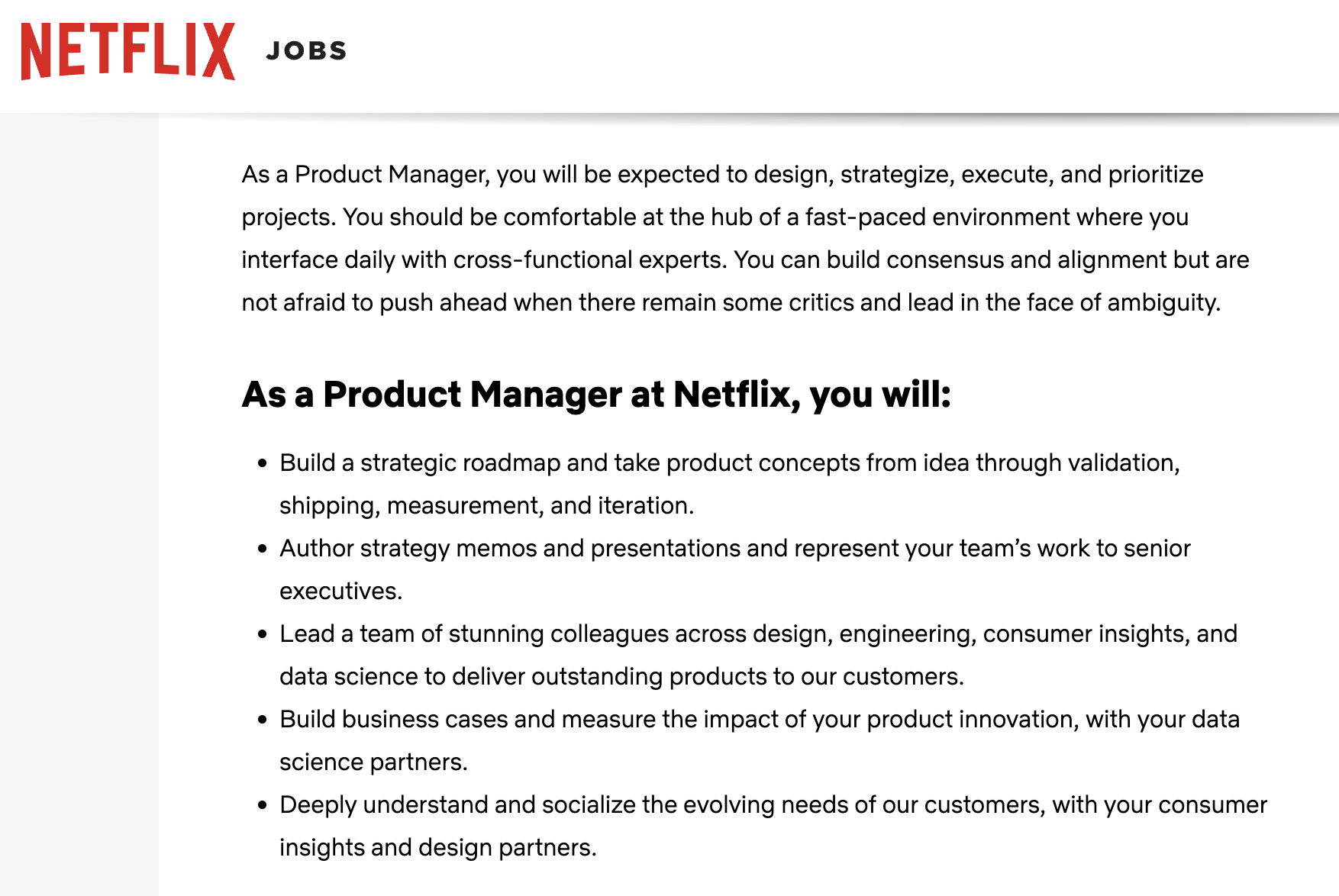
In this role, the product manager is responsible for building a strategic roadmap and taking product concepts from idea through validation, shipping, measurement, and iteration. They are also expected to “author strategy memos and presentations, and represent the team’s work to senior executives.”
Further responsibilities include leading a team of colleagues across design, engineering, consumer insights, and data science to “deliver outstanding products” to Netflix’s customers, as well as building business cases and measuring the impact of product innovation (in collaboration with data scientists).
The product manager must also “deeply understand and socialize the evolving needs of customers” in partnership with designers.
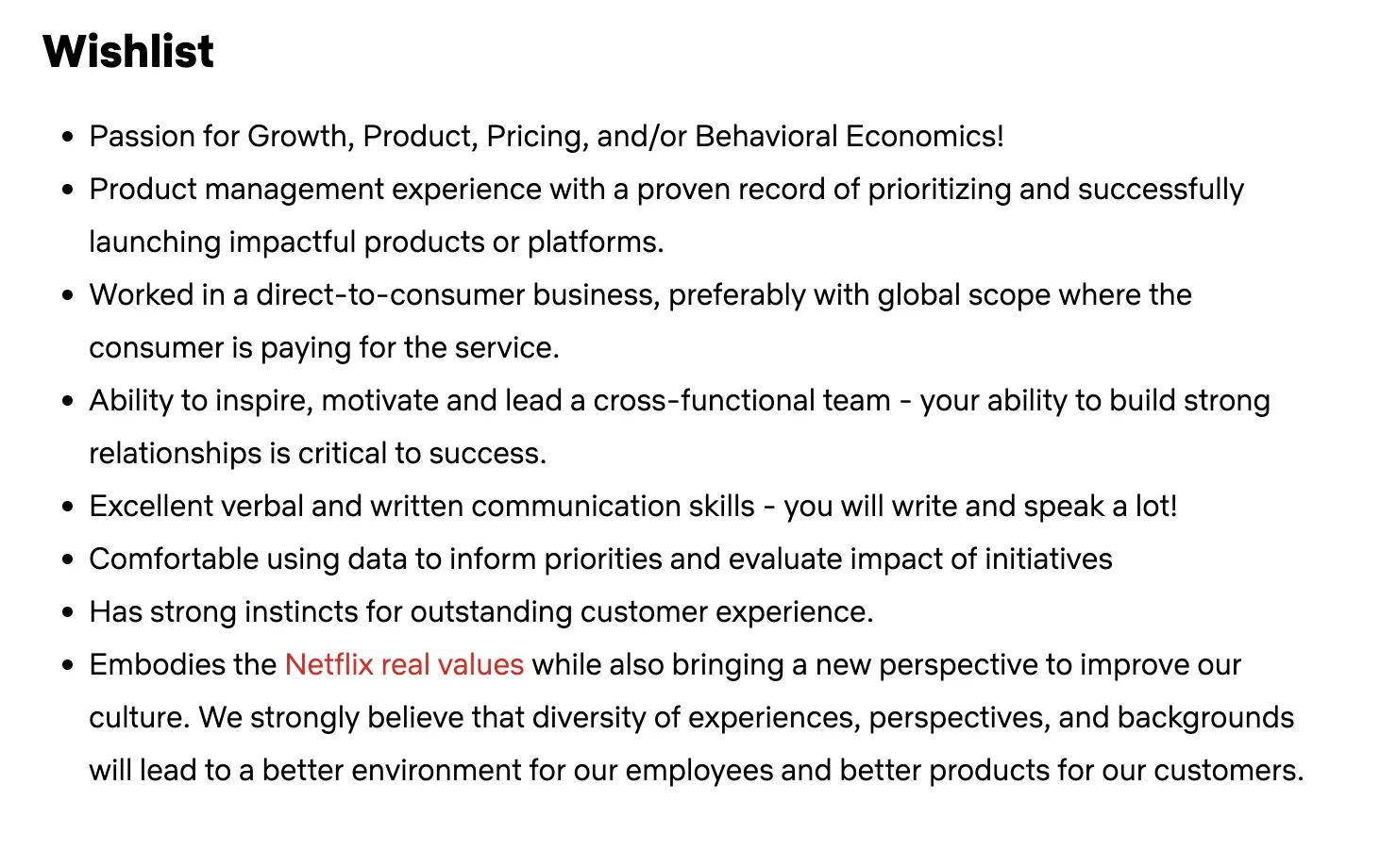
Netflix describes the ideal candidate for this role as someone who has a passion for growth, pricing, and/or behavioral economics, as well as a proven record of prioritizing and successfully launching impactful products or platforms.
Additional key qualities on the wishlist are “the ability to inspire, motivate, and lead a cross-functional team” and “excellent verbal and written communication skills.” The product manager must be equally comfortable “using data to inform priorities and evaluate impact of initiatives” and have “strong instincts for outstanding customer experience.”
American Kennel Club
Now let’s consider a junior product manager job description, posted by the American Kennel Club. In this role, the junior/associate product manager will “act as the voice of the customer when decisions need to be made about strategy and priorities for future feature development, including keeping up-to-date with the market and competitors.”
The ideal candidate should be “curious about developing a deep understanding of user-centered design” and always be “looking for ways to improve the experience of the user.”

In terms of day-to-day tasks, the American Kennel Club expects the junior product manager to help set product strategy, prioritize features, and develop and ship high-quality products in coordination with stakeholders, design, and development.
They are responsible for translating requirements from stakeholders into tasks and projects for the development team to tackle, working with the development team to “usher tasks through the development workflow”, and working with the UX design team to “propose both short- and long-term improvements for end users.”
Additionally, this particular junior product manager role includes communicating project status to partners, performing quality control on products, and leading meetings and presentations with various groups.

To excel in this role, the junior product manager must demonstrate working knowledge of market research, consumer behavior, and marketing techniques, as well as an ability to collaborate and coordinate with many different stakeholders.
In addition to strong interpersonal skills and user empathy (a common thread in all product manager job descriptions), this particular role requires general knowledge of HTML and CSS or JavaScript, knowledge of project management tools like Jira and Trello, as well as a strong drive to learn on the job.

As you can see from these three job ads, the product manager takes on a highly collaborative role that spans business, technology, user experience, and market research.
Now we’ve explored the product manager job description, let’s compile our own list of the typical day-to-day tasks and responsibilities a product manager can expect. Onto section four…
4. What does a product manager do? Responsibilities & day-to-day tasks
The product manager guides a product or service through each stage of the product life cycle, and their day-to-day tasks will vary depending on what stage the product is at.
The product life cycle spans discovery and development of the product, introduction of the product to the market, growth (where demand for the product increases), maturity (when initial growth begins to stabilize), and eventually, decline.
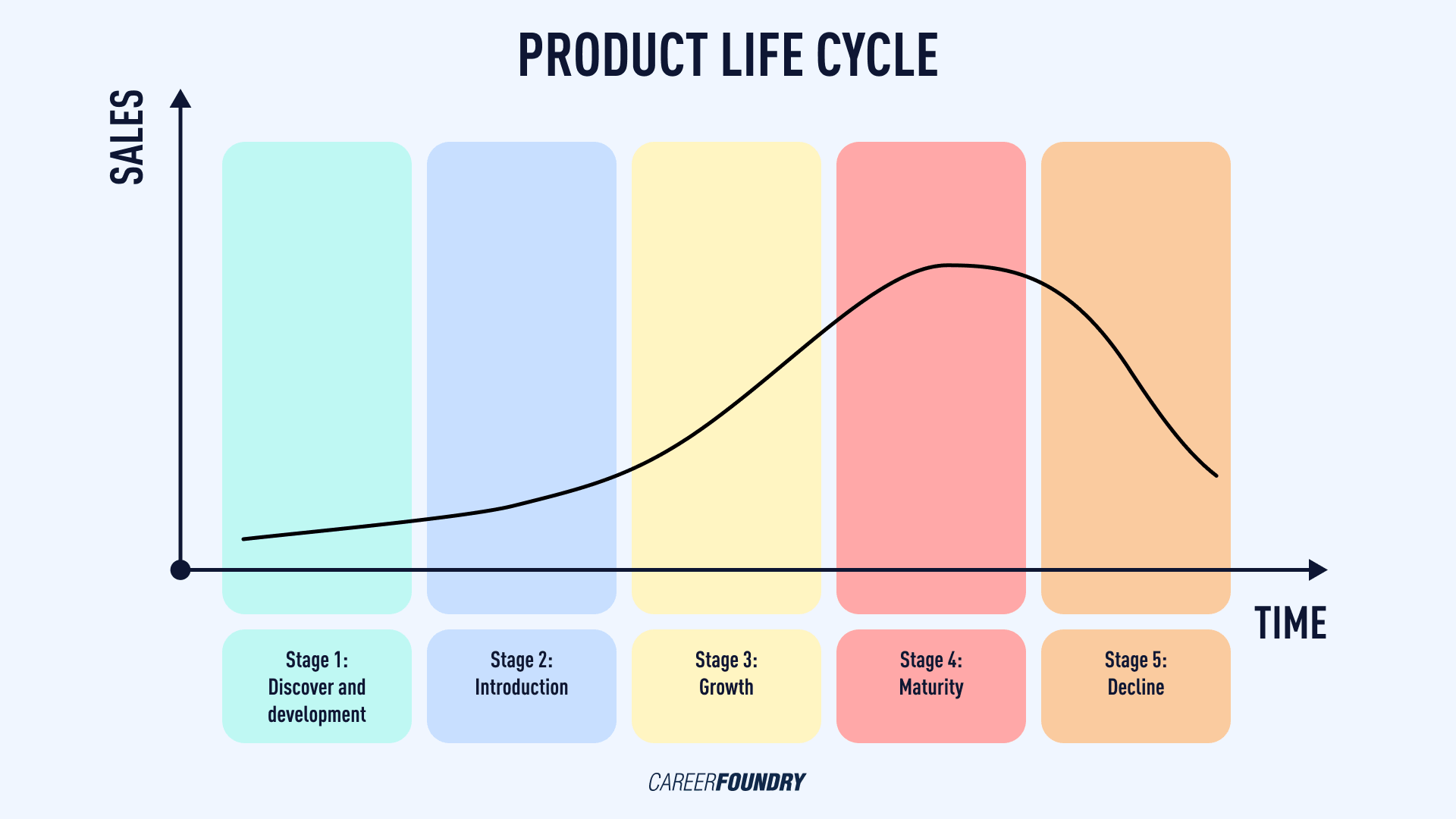
What are the responsibilities of a product manager?
Generally, the product manager is responsible for:
- Understanding and advocating for the end user’s needs
- Gathering and managing ideas which come from different stakeholders and departments
- Developing an overall vision and direction for the product
- Writing product specifications—a document which sets out the requirements of the product, outlining what will be built and why, what the new product or feature should achieve, and how success will be measured
- Creating a product roadmap (i.e. the strategic plan of action for the product)
- Prioritizing what should be built and when, based on user needs and business goals
- Working closely with the design and development teams to oversee the development of the product
- Running analytics and experiments to gauge how the product is performing and to find opportunities for improvement
- Capturing and organizing user feedback
What are the day-to-day tasks of a product manager?
Within these broader areas of responsibility, the day-to-day tasks of a product manager may include:
- Curating and managing an ideas backlog, prioritizing which problems to solve and when based on wider company goals and user needs
- Conducting market and competitor research
- Working with engineers and designers to define product requirements
- Defining success metrics for the product
- Translating stakeholder requests and requirements into tasks and projects for the development team
- Writing user stories in collaboration with engineers/developers and turning them into tickets (i.e. tasks) to be worked on
- Creating a product roadmap to lay out the product vision and set goals and milestones for the development of the product
- Working closely with customers, stakeholders, designers, and engineers to build proof of concepts and prototypes, give and receive feedback, and refine product requirements
- Communicating with (and often presenting to) the leadership team to secure approval for product initiatives
- Building strong cross-functional relationships, advocating for the product roadmap, and gathering input from other teams
- Helping to design and run experiments, and commissioning customer insights and user research to inform product decisions
- Working closely with marketing and sales teams to drive adoption of the product by new customers
- Identifying opportunities for product improvements, changes, and additions
- Acting as the number one point of contact for anything relating to the product
The exact tasks carried out by a product manager will depend on the size and setup of the product management team and the wider organization—as well as on seniority level.
Either way, all product managers can expect to collaborate closely with many different stakeholders, to play a hand in shaping the vision and strategy of the product, to delve into user research and customer needs, and to be responsible for managing and prioritizing the development of the product.
5. How much do product managers earn?
Not only do product managers enjoy a varied, rewarding career path; they also have the potential to earn well, too. So what is the average product manager salary?
According to data from Indeed, the average product manager salary in the United States comes in at just over $108,000 per year.
Here’s how product management salaries can vary based on seniority level:
- Junior product manager salary: $68,156 per year
- Associate product manager salary: $72,656 per year
- Product manager salary: $91,276 per year
- Senior product manager salary: $126,374 per year
- Director of product salary: $162,788
- Principal product manager salary: $172,880 per year
- VP of product management salary: $191,021
For the average product manager salaries around the world, and for different positions, check out our full product manager salary guide.
6. What skills do you need to be a product manager?
As we’ve seen, the role of the product manager is a varied one, spanning multiple disciplines. The best product managers are excellent communicators, relationship-builders, and problem-solvers. They have some technical know-how, are familiar with user experience principles, and are comfortable working with data.
We’ve rounded up all of the most important product manager skills in this guide, and here they are at a glance:
- Technical know-how: Product managers don’t need to be able to code, but they do need to be able to collaborate closely with developers. It’s important to have at least a basic understanding of the development process and the technology behind your product.
- A user-centric mindset and an understanding of UX principles: Product managers must advocate for the end user’s needs throughout the product life cycle, so a user-centric mindset is a must. Equally, it’s important to understand the UX design process and fundamental UX principles.
- Business acumen and strategic thinking: While advocating for the user, product managers are also responsible for driving growth for the business. They need to be strategic, think critically, and be well-versed in key business metrics.
- An ability to problem-solve: Problem-solving is a constant in the product manager role. In addition to solving user problems, product managers apply their problem-solving skills internally to optimize processes and overcome organizational, technical, and operational constraints.
- Excellent interpersonal skills: Product managers are in touch with different stakeholders on a daily basis, whether it’s presenting new ideas, sharing status updates, or gathering feedback. If you want to be a successful product manager, you’ll need to hone your communication, collaboration, and presentation skills.
The list of skills required of a product manager may seem overwhelming, but don’t let that deter you. Many of these skills are transferable and can be developed in unrelated fields. You probably possess a few of them already! With that, let’s take a look at how you can get started in product management.
7. How to become a product manager
If you’ve enjoyed reading about the role of the product manager, you might be wondering: How can you break into this exciting field?
The most important step is to develop the essential product management skills. Start with plenty of background reading and topic exploration through blogs, books, and podcasts. From there, consider a free introductory product management course to move from theory towards practical learning.
And, if you’re intent on making a career change and landing a job in the field, it’s worth completing an official product management certification. This will guide you through a structured learning path, equip you with the hands-on skills employers are looking for, and leave you with a professional portfolio and a recognizable qualification to demonstrate your expertise.
If you’d like to learn more about how to break into the field, we’ve put together a step-by-step guide on how to become a product manager.
That just about concludes our exploration of the product manager role. Hopefully you now have a clear idea of what a product manager actually does, as well as the skills you’ll need to make it in this exciting field.
If you’d like to learn more about the world of product management, take a look at these articles:
